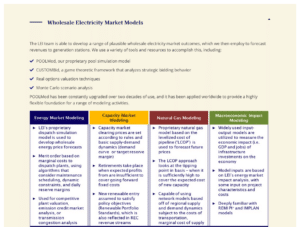The Problem & The Solution
If we have long content in each accordion tab, it might cause a bad experience when we toggle another tab because the content will be misaligned. Please fix this issue with script below.
In this case we use .elementor-tab-title as a selector
jQuery( document ).ready( function( $ ) {
$( '.elementor-tab-title' ).click( function( ) {
var pane = $(this);
setTimeout(function(){
var $panel = pane.closest('.elementor-accordion-item');
$('html,body').animate({
scrollTop: $panel.offset().top -100
}, 500);
}, 500 );
});
});
For more information, please check the links below
Example
The LEI team is able to develop a range of plausible wholesale electricity market outcomes, which we then employ to forecast revenues to generation stations. We use a variety of tools and resources to accomplish this, including:
- POOLMod, our proprietary pool simulation model
- CUSTOMBid, a game theoretic framework that analyzes strategic bidding behavior
- Real options valuation techniques
- Monte Carlo scenario analysis
POOLMod has been constantly upgraded over two decades of use, and it has been applied worldwide to provide a highly flexible foundation for a range of modeling activities.

We employ techniques such as total factor productivity modeling and data envelopment analysis to determine the relative and potential efficiency of network industries. These techniques identify the magnitude of potential cost savings for particular networks, and thus the possible upside under incentive-based rates.
We employ techniques such as total factor productivity modeling and data envelopment analysis to determine the relative and potential efficiency of network industries. These techniques identify the magnitude of potential cost savings for particular networks, and thus the possible upside under incentive-based rates.
We employ techniques such as total factor productivity modeling and data envelopment analysis to determine the relative and potential efficiency of network industries. These techniques identify the magnitude of potential cost savings for particular networks, and thus the possible upside under incentive-based rates.
We employ techniques such as total factor productivity modeling and data envelopment analysis to determine the relative and potential efficiency of network industries. These techniques identify the magnitude of potential cost savings for particular networks, and thus the possible upside under incentive-based rates.